Atlantic City & Shore Railroad “Shore Fast Line” cars 101 and 102 have entered operation on my Main Line Transit. The prototypes were built by John Stephenson Company, a J.G. Brill subsidiary in Elizabeth, New Jersey in 1906, part of a 20-car order, which included 17 double-ended coaches (101-117), two combines (118 and 119), and a funeral car, initially named the Absequam. The funeral business was dead (forgive the pun), since unlike some other systems, the line was not near any cemetery and complicated transfer of the departed’s remains and family members was impractical. The Absequam was converted to a coach and became car 120. Combine 119 later became a shed at the car house at the Inlet in Atlantic City.
The line connected Atlantic City and Ocean City with a roughly 18 mile run that included two lengthy causeways crossing Absecon Bay: one from Atlantic City to Pleasantville, with third rail operation, and another from Somers Point to Ocean City. Both ends of the line were at the respective Boardwalks in each terminal city: at Virginia Avenue in Atlantic City after sharing several blocks of trackage with the Atlantic Avenue line, and at 8th Street at the Boardwalk in Ocean City. Besides serving the two terminal destinations, intermediate service was provided to several well-established communities along the line, including Pleasantville, Northfield, Linwood, and Somers Point. The line was built to high standards and was owned by the Pennsylvania Railroad. The running time, including significant street running in Atlantic City and Ocean City, was around 55 minutes-comparable to other similar operations for lines of that length. The 20 cars were the only vehicles ever to serve the line and ran from the opening in 1907 until closure in February 1948. Due to storm damage to the causeway from Somers Point to Ocean City, the route was truncated in 1946 and ran only from Atlantic City to Somers Point in its final months of operation. In 1945, the PRR divested itself of the Shore Fast Line and the Atlantic Avenue trolley operation and the new owners planned for prompt conversion of the Shore Fast Line. The Atlantic Avenue line with its iconic Brilliners was converted to bus operation in December 1955.
The Shore Fast cars originally had wooden exteriors, but the elements of salt air and extremes of temperatures took a brutal toll. Beginning in around 1920, 13 of the cars, including 101 and 102 received exterior steel sheathing. This marginally lengthened the needed intervals between repainting. The initial color scheme was Pennsylvania Tuscan Red. In 1920, Traction Orange with Cream between the belt rails and letter boards was substituted, consistent with the Nearside cars that served the Atlantic Avenue route. The cars also had Bullseye Logos on the ends, which made for an attractive scheme. Tuscan would remain on the windows frames and doors, with black lettering on the cars. The most striking scheme appeared in 1935, with introduction of the famous “Bow Tie” livery with white/ cream bow ties on the car ends and triangles next to the doors. Initially, the triangles were short and subsequently were lengthened. This was part of attempt to recover ridership lost in the Depression years, along with amenities such as on board hostesses. The service was frequent and reliable, however the rolling stock was old and the seasonal nature of traffic between the two resort cities, along with post-World War 2 automobile proliferation resulted in the demise of the AC&S, after which all remaining cars were scrapped.
The HO Model!
The project was conceived by East Penn member John Kennedy, a manufacturer of high-quality models and supplier of essential finishing parts for HO traction models. John had planned a resin-cast model. Due to several personal issues, John collaborated with Volkmar Maier of Paris, a pioneer in 3-D printing of traction and super customer-friendly manufacturer who meticulously researches his plans and preemptively troubleshoots any anticipated problems. In early 2022, Volkmar had the models prepared for distribution; many East Penn members and friends easily yielded to the temptation to purchase them. The shell is highly detailed, including the characteristic roof bell, roof ladders, and vestibules at each end. The floor is built to accept the Bowser 125115 drive with the 6 ft.-6 in. wheelbase and 33 scale-inch wheels. The floor contains all appropriate details including truss rods, and underbody equipment, couplers, steps, and pilots. The pole retrievers are removable for painting and decaling of the shells. The trolley boards, which include the bell and car number box (not utilized in later schemes and blacked out during World War 2) and correct placement for the trolley poles. The bolster for the Bowser drive is precise and easily affixed with 3mm hex-head screws. The drive bolster is easily replaced with an available screw-in insert for those who wish to make an unpowered trailer car. The floor is screwed into the body via the bulkhead bolsters, also with 3 mm. hex head screws. The end bumpers are intended to be cemented in place when the car is finished, and this is easily accomplished with some medium ZAP and careful alignment. The side frames are accurate and made for easy compression onto the pegs in the Bowser drive. Volkmar provided us with a generous stash of spare parts, recognizing at least in my case, the ease of screw-ups.
George Huckaby of Custom Traxx made the decal set. It is comprehensive and includes all car numbers instead of individual numerals, with enough to place the numbers on each car end and on the sides. The bow ties and triangles-both long and short triangles are provided, depending on the modeler’s choice, as are a generous choice of destination signs. There are matching white/cream decals to apply on the window posts, both on the side and on the end windows, and matching belt rail stripe. Also included is the ATLANTIC CITY OCEAN CITY side lettering. A choice is provided of either the straight or the crescent ATLANTIC CITY. The letter board arrow logos are provided which have SHORE FAST LINE.
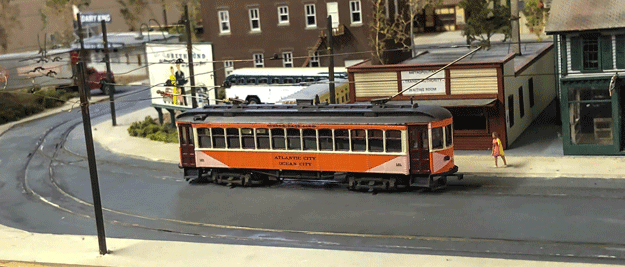 AC&S 101 with straight side lettering in the siding at New England Village! AC&S 101 with straight side lettering in the siding at New England Village! |
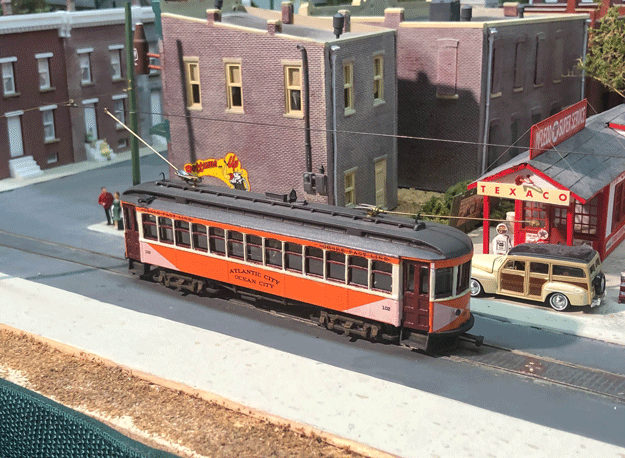 AC&S 102 with the side lettering arriving at Keystone Junction. AC&S 102 with the side lettering arriving at Keystone Junction. |
For anyone who wants to do a pre-bow tie scheme, George has provided the logos that were under the right end windows, and that had been on the Atlantic Avenue pre-Brilliner Nearside cars. The shell was cleaned with dish soap, which worked well, since the prior waxy residue associated with 3-D prints was not a problem with Volkmar’s prints. The car was sprayed with an Aged White, and then masked and Reefer Orange sprayed. The roof and underbody and side frames and pole retrievers were sprayed with a Grimy Black. Rust was dry brushed onto the side frames, underbody, and pilots. Painting the Tuscan window frames on the ends and sides, and the doors was not for the impatient. Using a fine bush, and in some places a toothpick, I managed to do the best I could. I looked up articles and YouTube videos for ideas on how to do it and the only advice was to do the best you can. The model entails a lot of decaling. For the two cars I did, each took roughly 6-8 hours. George had cautioned great care with the arrow logos for the letter boards due to fragility. I only screwed up one. I also messed up with one bow tie, but had a spare set of decals, so no harm no foul. The white that we used for spraying was not a perfect match for the white of the bow ties-the pigment on the bow ties applied on top of the orange was a tad thin, but once the white decals were applied to the windows posts, an acceptable match. Once the decals were in place, Dull Coat was applied to anchor everything. The holes for the pole retrievers then were poked from the inside of the ends with a 25 gauge-5/8-inch needle-sometimes it pays to work in healthcare!
I used Custom Traxx #12508 pole bushings which fit perfectly vertically in the apertures that Volkmar has fashioned.
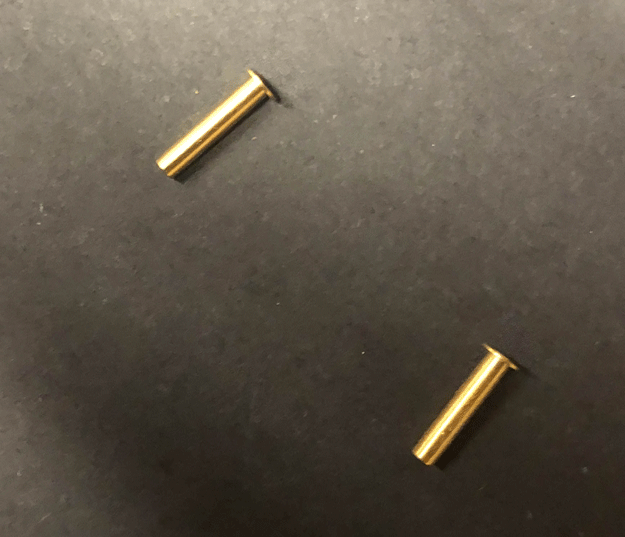 Bowser #12508 Trolley Pole Base Bushings! Bowser #12508 Trolley Pole Base Bushings! |
The Bowser drive was easy to install, and the trucks had adequate swing for the Orr switches on my layout with a 6-1/8-inch radius. Some weight is need for navigating tight turnouts and my 4% grades, but it was easy to address. After a long hiatus, recently I was able to find 7.5-gram (aka ¼ oz.) lead weight tabs at the Great Scale Train Show at Timonium, Maryland. I have never had much luck with the steel weights, which are insufficiently weighty and impossible to cut. Another find was Tungsten Putty, easily available where Pine Box Derby supplies are sold. From Amazon, a 2 oz. can is available for $14 and is enough for 6-8 cars. Cut a piece, shape it, and attach wherever. A bit of that, and a lead tab on top of the gear tower, and a lead tab in the clerestory in front of the front pole bushing and smooth running through turnouts and grades.
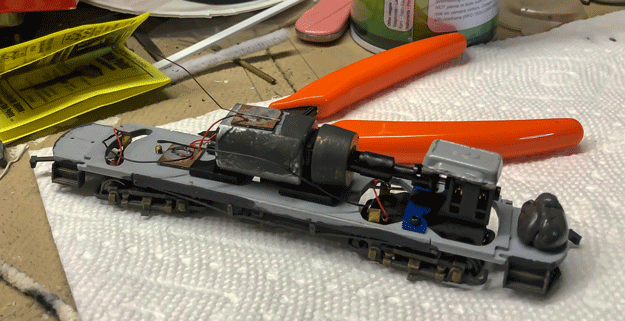 Bowser 125115 mechanism with A-Liner 20040 Trolley Flywheel Kit installed on AC&S Floor! Bowser 125115 mechanism with A-Liner 20040 Trolley Flywheel Kit installed on AC&S Floor! |
The poles I am using are the Rich Eaton 14 scale foot poles with pin-type bases and sliders. The pole hooks were fabricated with 0.03 x 0.01 brass strips, inserted through small holes drilled into the roof near the ends of the trolley boards. At some point, some cars had ”gull wing”-type pole hooks, which can also be made with similar brass strips soldered together where they penetrate the roof and divided by their crooks. The window glazing was unique for these cars. There is no space for horizontal overlap. The side window glazing must be exactly 34 scale feet to fit into the space between the bulkhead braces; the windows on the doors must be exactly 2 feet horizontally. The glazing for the end windows should be exactly 6 ft.-3 inches. For the ends, a thin and flexible acetate should be used to fit snuggly against the inside of the window apertures on the ends. Prior to cutting the acetate for the windows, I cut out black craft paper that I precisely sized to fit where the window glazing would fit and used the craft paper pieces as templates for the acetate, saving myself a ton of grief.
A few minor imperfections that I am willing to live with:
-
There is some inevitable grooving in the 3-D printing on the roof. This is unavoidable. A more expensive printing process might have eliminated that, but to his credit, Volkmar was eager to keep the kits affordable.
-
Painting the windows is a challenge, and as stated, I did the best I could.
-
The white/cream decals have a bit of a cast where they are applied to the orange for the bow ties and triangles. Alternatives entail either painting instead of decaling the bow ties and triangles, or alternatively, using a double layer of the decals, which will be challenging but not impossible to precisely align.
That said, these are very satisfying models. I was able to make them operational in one evening, with another for tweaking the weights. Final assembly after finishing was not difficult. I wanted to do 2 cars with the bow tie scheme: one with the straight ATLANTIC CITY and one SHORE FAST LINE arrow logo in the letter board (101) and another with the crescent ATLANTIC CITY and 2 SHORE FAST LINE arrow logos on the letter board (102). Modelers should check available photos for accurate selection of desired car numbers to create an accurate representation of the prototype.
Hopefully other modelers will learn from my errors and, someone will avail themselves of the nice bullseye logos for the ends in the 1920-1935 pre-bow tie scheme! And if someone comes up with a working coupler, a two-car train can be made, such as served the line in the long-ago busy summer months.
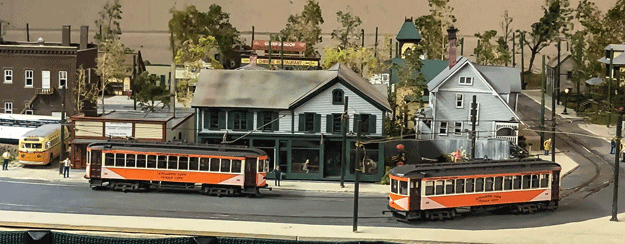 AC&S 101 and 102 meet at New England Village. AC&S 101 and 102 meet at New England Village. |
The credits are extensive:
-
John Kennedy of KND. John originally conceived of this project. His meticulous attention to details and accuracy contributed to its delay, but above all to its excellence. John has a legacy of outstanding models and superb and responsive customer service. He is one on the giants.
-
Volkmar Meier of Paris. Volkmar is a pioneer and innovator for 3-D printed traction kits and like John is attentive to details and sensitive to issues such as mishaps in construction and does everything possible to make it hard for the modeler to fail. He is responsive to questions and willing to take a second look when a problem arises. And he also tries to keep the models affordable without compromising on quality. Volkmar is also constantly learning and innovating with such details as how and where to weight the cars where needed.
-
George Huckaby of Custom Traxx. George was “all in” in support of this project, including with manufacture of comprehensive decal sets with detailed instructions about each car. He is very attentive to details and prompt in his reply to inquiries. He was also a source for working pole bushings and needed drives and advice about nice finishing touches such as the gull wing hooks. He provided invaluable advice about finishing.
-
Bowser Manufacturing for the reliable drives, that it my case are the “go-to”, are affordable, and easy to install and if necessary, repair.
-
Rich Eaton, whose poles make my life easier.
-
Our late friend and fellow East Penn member, Professor Jim Henwood, whose posthumously published CERA book "Trolleys to the Boardwalk" is a vital resource for information about all things AC&S -related.
-
Melvin Borgnis, whose book "We Had a Shore Fast Line" has many useful details and photos. And to Tom Lederer, who generously loaned me his book.
-
Andy Maginnis, whose drawings of the Shore Fast cars were valuable for reference.
-
The many modelers who purchased these car kits. Supporting our quality manufacturer assures ongoing interesting offerings.
-
Bob Dietrich, whose good company, advice, and assistance with keeping me focused and with help with painting and when needed, indispensable constructive criticism.
This model has deservedly been a significant success for purchasers and providers. As long as interesting offerings like this are available, traction modeling is and will be alive and well!